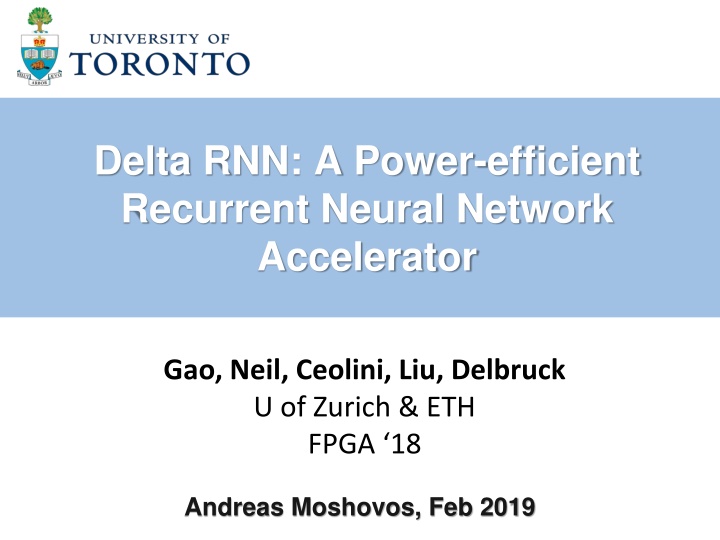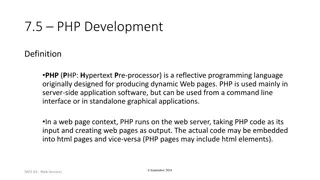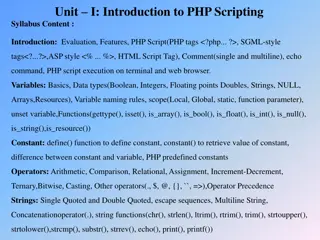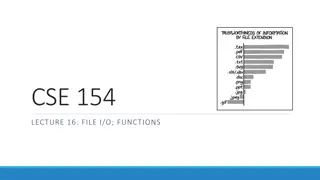
Efficient Accelerator for Recurrent Neural Networks
Explore the Delta RNN, an energy-efficient accelerator for Recurrent Neural Networks (RNNs), addressing the challenges of vanishing gradients and long-term memory. Learn about the unique Delta Network Algorithm, FPGA implementation, and applications in Natural Language Processing.
Download Presentation

Please find below an Image/Link to download the presentation.
The content on the website is provided AS IS for your information and personal use only. It may not be sold, licensed, or shared on other websites without obtaining consent from the author. If you encounter any issues during the download, it is possible that the publisher has removed the file from their server.
You are allowed to download the files provided on this website for personal or commercial use, subject to the condition that they are used lawfully. All files are the property of their respective owners.
The content on the website is provided AS IS for your information and personal use only. It may not be sold, licensed, or shared on other websites without obtaining consent from the author.
E N D
Presentation Transcript
Delta RNN: A Power-efficient Recurrent Neural Network Accelerator Gao, Neil, Ceolini, Liu, Delbruck U of Zurich & ETH FPGA 18 Andreas Moshovos, Feb 2019
Overview RNNs Why? Temporal Sequences Output depends on history not only current input Vanishing Gradient Problem Long-Short Term Memory Gated Recurrent Unit This work All use multiple Fully-Connected (maybe different now?) Bottleneck: Memory traffic for weights Delta Network Algorithm Only process activation and input changes if above a threshold Temporal correlation Delta RNN FPGA Implementation of DN Natural Language Processing 2
Recurrent Neural Nets Layers Temporal Sequencex(t) To Be or Not to Be h(t) FC FC FC h(t-1) 1 step delay Output Depends on: 1. Current Input 2. Previous outputs Captures Temporal Correlations
Vanishing Grandient Problem: Training x(t) x(t-n+1) x(t-n) FC FC FC FC FC FC h(t) h(t-n-1) h(t-1) h(t-n) h(t-n+1) Impact of long term memory hard to capture Attenuates severely
Gated Recurrent Unit: Example Use Their Test Network Regular Net: 5 FCs 5
Gated Recurrent Unit: Structure Inputs: x(t) and h(t-1) Output: h(t) 6
Gated Recurrent Unit: Structure Three gates : r: Reset u: Update c: Candidate 7
Gated Recurrent Unit: Structure r: Reset: Amount of previous hidden state added to candidate hidden state u: Update h should be updated by candidate hidden state enable long term memory What do these mean? 8
Gated Recurrent Unit: Structure Element wise b: biases 9
Gated Recurrent Unit: Structure u(t): keep feature s h(t-1) value or Update with c(t) Degree of each 10
Gated Recurrent Unit: Structure c(t): candidate Some of x(t)/current input or Some of hidden state h(t) 11
Where time goes in GRU RNNs Weight matrices Wxr, Whr Wxu, Whu Wxc, Whc Vector-Matrix Products 12
Where time goes in GRU RNNs: MxV Weight matrices x(t) Wxr(t ) h(t) sized Dense: Compute Cost: n^2 Mem Cost: n^2 (weight) + n (vector) 13
Sparsity Reduces Costs: Compute and Memory Sparsity in x(t) and h(t-1): what if value is zero x(t) h(t) sized Wxr(t ) Sparse : oc = occupancy, fraction of non-zero values Compute Cost: oc x n^2 Mem Cost: oc x n^2 (weight) + oc x n (vector) But not that much sparsity to start with 14
Delta RN: Increase Sparsity in x(t) and h(t-1) Key idea: update x(t) or h(t-1) iff change above threshold Intuition: Temporal correlation, some values don t change much Magnitude of change ~ feature importance 16
Delta RN: Increase Sparsity in x(t) and h(t-1) Delta GRU 17
Delta RNN: FPGA Implementation Xilinx Zynq FC Layers: ARM Core DeltaRNN: GRU Layer 18
Delta RNN: FPGA Implementation IEU: Delta Vectors MxV: Matrix x Vector AP: activations 19
Input Encoding Unit x(t) h(t) Dh(t) PT RegFile: Keep previous vectors to calculate Dx(t)/Dh(t) Update w/ current x(t) 4/cycle / 64b 16b Q8.8 h(t) 32/cycle / 256b Value/Index Sparse Representation Dx(t) AXI-DMA limiter 20
Input Encoding Unit: Delta Scheduler Encode non-zero values BW: 2 per cycle value/index 21
Input Encoding Unit: Delta Scheduler: Latency Dh(t-1) w/ 1024 elements Best Case: 0% occupancy (all zeros) 32/cycle input bound 32 cycles Worst Case: 100% occupancy (all non-zero) 2/cycle output output bound 512 cycles Dx(t) w/ 39 elements Padded to 40 Best Case: 0% occupancy 10 cycles, 4/cycle Worst Case: 100% occupancy 20 cycles (output bound) 22
MxV Unit 3 Channels: R, U, C R: Mr(t), U: Mu(t), C: Mcx(t) & Mch(t) 128 Mul + 128 Add / 16b Q8.8 DSP + LUTs 32b 23
Scheduling Since h(t) tends to be longer than x(t) First do Dx(t) all MxV channels do Dx(t) Overlaps with calculating Dh(t) 24
MxV Unit: Scheduling Weights from BRAM true dual-port Can do two products per column Guessing: data width of BRAM ports? 25
AP: can use MxV multipliers MxV busy only when both Dx(t) & Dh(t) have non-zeros AP BW is low MxV will be idle ??? reuse it for AP 26
AP: can use MxV multipliers S1 / S5: 16b addition S2: 32b addition S2/S4: 32b mul Q16.16 Q8.8 into S5 27
Activation Functions Range Addressable LUT 28
Accuracy: theta during training vs. inference Better use the same Theta 0x80 only 1.57% loss 30
Theta vs. Throughput & Latency Great Benefits 31
Sparsity and Speedup vs. Theta better 32
Power Measurements Measured @ Wall-Plug w/ Volcraft 4500Advanced Base+fan: no FPGA board 7.9W + Zynq w/ no programming 9.4W (9.7 above?) w/ programming 10W w/ prog + running 15.2W Zynq MPP = 15.2 7.9 = 7.3W Zynq Chip = 15.2 9.7 = 5.5W Power Analyzer @ 50% activity PowerAnalyzer: DRNN 2.72W BRAM 2.28W 33
Summary 34






















